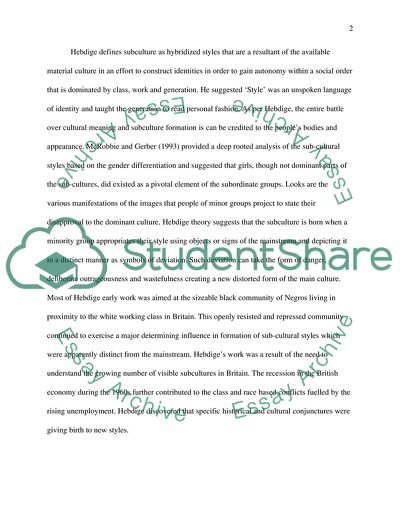Cite this document
(Tthe Style of the Subgroups Case Study Example | Topics and Well Written Essays - 2500 words, n.d.)
Tthe Style of the Subgroups Case Study Example | Topics and Well Written Essays - 2500 words. Retrieved from https://studentshare.org/sociology/1719735-outline-hebdige-work-on-subcultural-groups-with-reference-to-his-use-of-the-terms-resistance-and-bricolage-are-his-views-still-valid-when-looking-at-contemporary-subcultures
Tthe Style of the Subgroups Case Study Example | Topics and Well Written Essays - 2500 words. Retrieved from https://studentshare.org/sociology/1719735-outline-hebdige-work-on-subcultural-groups-with-reference-to-his-use-of-the-terms-resistance-and-bricolage-are-his-views-still-valid-when-looking-at-contemporary-subcultures
(Tthe Style of the Subgroups Case Study Example | Topics and Well Written Essays - 2500 Words)
Tthe Style of the Subgroups Case Study Example | Topics and Well Written Essays - 2500 Words. https://studentshare.org/sociology/1719735-outline-hebdige-work-on-subcultural-groups-with-reference-to-his-use-of-the-terms-resistance-and-bricolage-are-his-views-still-valid-when-looking-at-contemporary-subcultures.
Tthe Style of the Subgroups Case Study Example | Topics and Well Written Essays - 2500 Words. https://studentshare.org/sociology/1719735-outline-hebdige-work-on-subcultural-groups-with-reference-to-his-use-of-the-terms-resistance-and-bricolage-are-his-views-still-valid-when-looking-at-contemporary-subcultures.
“Tthe Style of the Subgroups Case Study Example | Topics and Well Written Essays - 2500 Words”. https://studentshare.org/sociology/1719735-outline-hebdige-work-on-subcultural-groups-with-reference-to-his-use-of-the-terms-resistance-and-bricolage-are-his-views-still-valid-when-looking-at-contemporary-subcultures.


